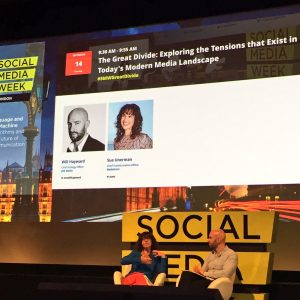 This month JoeMedia took on the big topic of whether Social Media is dividing us or bringing us together.
This month JoeMedia took on the big topic of whether Social Media is dividing us or bringing us together.
As their CSO Will Hayward pointed out at the recent Social Media Week London conference there’s been a huge stepchange in democratising news because of Social.
News is no longer curated by a set of editors sitting in Fleet Street as it was last century. We can all find out what’s going on all the time anywhere in the world. This is a privilege and a burden at the same time. To a greater or lesser extent, we learn about what’s going on from sources that confirm our existing biases – and it is arguable whether this is more or less true than in the pre-internet era.
Alongside the democratisation of publishing has come much more visibility of hate and harrassment.
Do these two trends go along together? Most readers will applaud the openness of opinions and at the same time deplore the hatred. Is one the necessary consequence of the other?
Here’s Hayward’s important question: “In light of GamerGate, harassment of non-CIS gender white males on line and general casual misogyny, has social media really had a positive impact on society?”
The Fawcett Society doesn’t wholeheartedly agree that is has. Fawcett – a UK based campaigning organisation for gender equality that has been around since before there was TV let alone the internet – has launched #ReclaimtheInternet, to combat the rise of cyber-bullying, revenge porn and online abuse.
On the other hand the internet has given a voice to communities that were previously silent. Mums at the school gates for instance always have had strong opinions. Now those opinions can’t be ignored thanks to sites like Mumsnet and Netmums. #Everydaysexism has given everyone an insight into harrassment calling out behaviour online but also in the real world that’s surely unacceptable by most people’s standards.
A Demos survey a couple of years ago calculated that there are on average 9000 misogynist tweets a day. Twitter’s verification tick has improved the experience online (to an extent.) Bruce Daisley, EMEA Twitter supremo, says that he’d verify every Twitter user.
This begs the question: does the ability to disguise your identity online bring out unacceptable behaviour? (Real character is how you behave when no one is watching.)
Social media encounters are different from real life ones; at the same time both better and worse than face to face conversations. They are not an accurate reflection of each other. A 2012 Harvard study found that in real life people use only about a third of personal conversations to talk about themselves (I’m sure we can all think of someone who stretches this stat, but this is on average). Online that number jumps to over three quarters. Your ego more than doubles in size when you go online. Part of the attraction is that it is all about you.
What you get from this is a world that is twice as good as anyone’s good traits and more than twice as bad as the worst traits.
In real life conversations we usually have to put our best selves forward. Most people do that most of the time online too. But, just as in the playground, you can find popularity through attacking those who are perceived to be weak. If we’re online, we have a choice. Will you be kind, will you be mean, or will you stand by and watch? What’s the role of the tech titans? To preserve freedom of speech or to moderate (censor) behaviour? Martha Lane-Fox said recently that we are at the inflexion point of the internet, it’s mid-life crisis. Time to take a step back and think.
We all have a choice because we are social media.
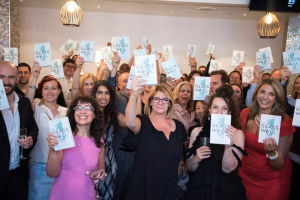

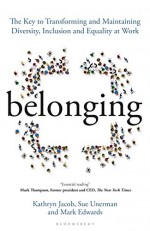
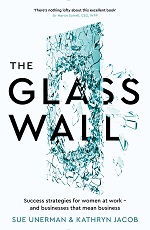
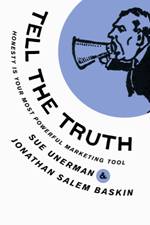
Why frequency matters
Friday, September 29th, 2017you used to, you used to
You used to call me on my cell phone
Late night when you need my love
What makes a hit a hit?
Since the dawn of popular music, two factors have mattered most, as reporter Derek Thompson explains in Hit Makers. A catchy song. Frequency of exposure.
There’s some science to prove this. iHeart Media owns a songtesting company called HitPredictor. They play hooks from songs to an online panel three times and the audience score the song. Songs can score into the 100s but any score above 65 is considered a potential hit.
Some of the biggest songs score well under 80. Beating songs that score in the 80s, 90s and 100s.
Drake’s “Hotline Bling” quoted above barely scraped 70 in the HitPredictor ratings, but was top five in the Billboard Hot 100 on release.
Songs become hits because if they’re catchy and have a good melody. They also need frequency of exposure.
Pop songs become hits when they’re familiar enough, both in their structure in general (people like something that sounds like something else that they liked) and when the specific song has had enough airplay or online exposure to be recognised.
This is of course not just true of pop songs. The Mona Lisa is the most famous painting in the world. Some argue that this is down to the incident in 1911 when it was famously stolen. This gave the painting immediate notoriety and exposure and as soon as it was recovered, two years later, queues of people lined up to see it, and are still doing so.
And of course this is why frequency matters in media. It’s not just that shared experiences are crucial. It is also that the more familiar we get with a brand (and its brand story), the more likely we are to buy it again.
Data analysis can now pinpoint the precise frequency that is optimal for a brand’s message. Frequency works (although as we know precisely only up to a point.)
Frequency works because it makes the brand easy to think of. Thinking that feels easy is called “fluency”. As Thompson writes: “Fluent ideas and products are processed faster and they make us feel better – not just about ideas and products we confront, but also about ourselves. Most people generally prefer ideas that they already agree with, images that are easy to discern, stories that are easy to relate to and puzzles that are easy to solve.”
Fluency lifts the brand from system 2 thinking (which is hard) to system 1 thinking (which is instinctive).
So frequency is good. But it is not infinitely good. Human beings like new things too. As we develop from babies we learn to love to operate in the zone of proximal development. Just outside our core comfort zone. Where stuff is new, but not too new. Different but sort of familiar. This is an educational term, but it can be useful as a concept for understanding why variations on a theme are so necessary, in marketing as well as in hit making in general.
When catchy tunes start to annoy you, when politicians bore you with the same buzzwords and when yet one more advert follows current trends slavishly then you need the new.
Audiences like the familiar, and they also like the welcome surprise. In media planning repetition is good, but frequency caps are crucial. In marketing sticking to the brand truth is crucial, but regularly surprising and delighting the audience is essential.
Posted in MediaComment | No Comments »